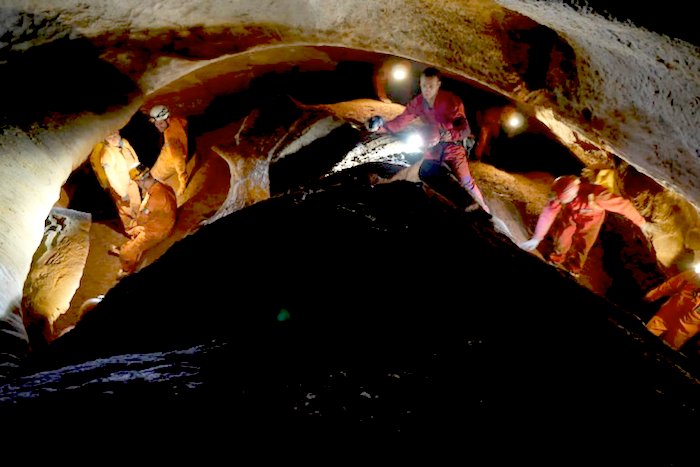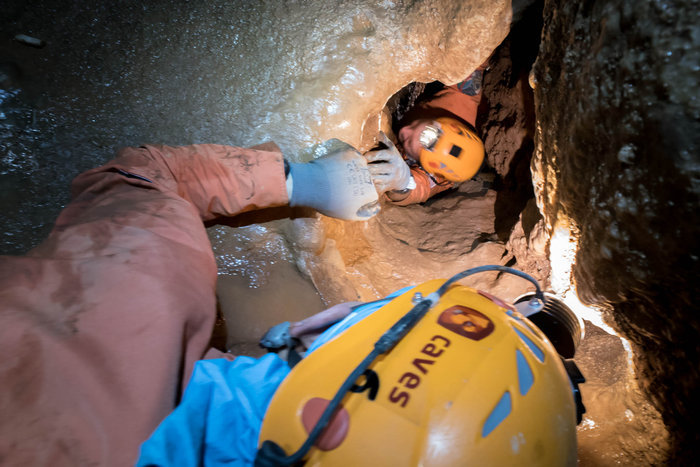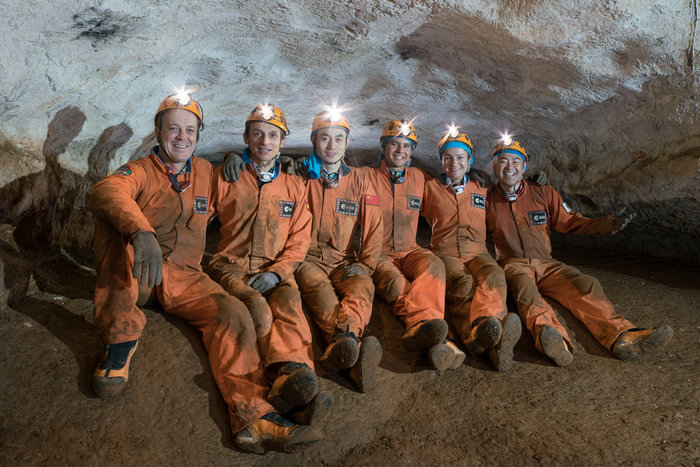.
23.06.2016

Last year’s blockbuster The Martian famously depicted NASA and Chinese astronauts setting off together for Mars, leaving many viewers wondering why the two powers can’t cooperate in space for the common benefit of human exploration.
Such collaboration has not been possible so far. China has only recently emerged as a player in human spaceflight, and NASA has been largely barred by legislation from bilateral activities with China’s space authorities over security concerns.
But despite this state of affairs, American and Chinese astronauts are for the first time set to work side-by-side, thanks to a multilateral mission set up by the European Space Agency (ESA) which starts on Friday.
ESA CAVES (Cooperative Adventure for Valuing and Exercising human behaviour and performance Skills) is an annual two-week-long analogue mission which simulates spaceflight here on Earth and helps prepare astronauts for working safely and effectively in multicultural teams and apply their training in a space-like context.
The team of ‘cavenauts’ for this year’s edition consists of one European astronaut, one from JAXA of Japan, two from NASA, a Russian cosmonaut and, for the first time, a Chinese astronaut - or ‘taikonaut’ to use the popular internet term - from China’s space agency, CNSA.
Together they will face the challenging environments of caves on the Italian island of Sardinia, sharing their flight or work experiences, and applying skills in a risk-filled expeditionary environment, which could prove to be a historic first step in wider human spaceflight between the Chinese and the other participating agencies.
Head of Instructional Technologies, Special Skills Training and Exploration Unit at the European Space Agency and leader of the CAVES training, says the project could well be important not just for future cooperation but also future planetary exploration.
“So we have started this training to train astronauts in an international environment to work together as teams. And it's been considered an efficient and effective training, so definitely it could be good also for seeing how astronauts and taikonauts or cosmonauts work together as teams.”
Two taikonauts, or more properly 'hangtianyuan' in Chinese, already underwent training with ESA in late 2014 in preparation for this year’s CAVES mission, and one of them will join up with the others in Sardinia.
Ms Bessone explains that the taikonauts preparatory training involved intercultural exchange, discussing different ways of communication, team work and making decisions.
“It was extremely important that the taikonaut participant would integrate within this scheme of feedback of open communication or open discussion because, of course, there are differences in the cultural perception of feedback between Europe, Japan, Russia and China. I wanted to make sure that this openness would not become a problem.”
After getting together this week and beginning training on June 24, the cavenauts will prepare for their week-long joint mission underground starting in early July.
“The participants find an occasion to work together as international teams, sharing their experiences, their flight experience or their work experiences, and apply their skills in a real expeditionary environment where they face risks. And they try their methods of working as a team, like communication, teamwork, decision-making, leadership and confronting each other with that.
“So it has much potential for them, and also a way for them to confront themselves with real explorative expeditions…I always expect for the participants to grow and to learn something about themselves, and about each other, about their team interactions and refine them in order to be able to improve them in the future,” Bessone says.
Tim Peake, the ESA astronaut from Britain who very recently returned to Earth after six months aboard the International Space Station, participated in the 2011 CAVES before making it to space.
NASA astronaut Jessica Meir, who holds a doctorate in Marine Biology, will this year be the first female participant in ESA CAVES.
Speaking from Houston before setting off for Europe, Meir expressed her keenness to be tested in a challenging underground environment and international context.
“This is a really great analogue for spaceflight. When we’re on the space station, we’re up there for six months at a time living and working with the same five other people, and sometimes in hostile environments in the sense that they take some survival skills,” Meir said.
“It’s a tremendous opportunity for us to utilise a habitat like that, and I think it’s going to be eye-opening to operate in an environment that requires very, very technical skills and a chance for all of us to learn the best way to work together as a team.”
While NASA participates in and hosts underwater and habitat analogue missions with international partners involved in the ISS, Meir recognises that she and fellow NASA astronaut Ricky Arnold have an extremely rare chance to work with a taikonaut, which adds to the international aspect of the ESA CAVES mission.
From CAVES to deep space?
Humanity has been stuck in low Earth orbit since the end of the Apollo days, but projects like ESA CAVES show that, as well as aiding current projects like the ISS, there is international planning and preparation for a future in deep space and planetary exploration, whether that will be NASA’s nascent plan for a ‘Journey to Mars’, or an international project closer to home.
With an eye on the future, ESA is already developing a Moon habitat to allow analogue testing for lunar missions, which could help astronauts prepare for a new era of space exploration.
Quelle: gbtimes
-
Update: 2.07.2016
.
CAVES: exploring inner space for outer space

Today, an international team of six astronauts from China, Japan, USA, Spain and Russia will descend into the caves of Sardinia, Italy, to explore the depths and train for life in outer space.
One of the last unexplored environments on our planet, caves offer parallels to exploring space. ESA’s underground training course “Cooperative Adventure for Valuing and Exercising human behaviour and performance Skills” – CAVES – prepares astronauts over two weeks to work safely and effectively in multicultural teams.
After a week of training, the astronauts are now descending into the caves to set up basecamp 800 m underground.
The similarities between caving and spaceflight are highlighted throughout the course. Speleologists and astronauts adopt the ‘buddy system’, and both astronaut trainers and CAVES instructors repeat the same mantras of “slow is fast,” “check your gear, and then trust it,” and “always be aware of where you are and where your buddy is.”
In every expedition, the astronauts work with seasoned instructors and explorers. “A mutual trust builds as stories and anecdotes are shared,” says mission director Loredana Bessone. “The atmosphere is always one of respect.”
CAVES focuses on multicultural approaches to leadership, following orders, teamwork and decision-making. At the end of the course the astronauts will have a better understanding of how they function in a multicultural team and what they are skilled at, as well as areas for self-improvement.
Behavioural activities are woven into the course to foster effective communication, decision-making, problem-solving, leadership and team dynamics.
“From the first activity together, the support team saw that this year’s ‘cavenauts’ would be a really tight crew,” says Loredana. “Their teamwork is an example of what an expedition in an isolated, risky and alien environment should be.”
This year’s participants are an even more international team than ever, including ESA’s Pedro Duque, NASA’s Jessica Meir and Richard Arnold, Japan’s astronaut Aki Hoshide, China’s Ye Guangfu and Russia’s Sergei Korsakov.
The cavenauts bring a broad mix of skills with their backgrounds in science, engineering, flying, military and education as well as experience and culture.
Pedro Duque comments, “It is a great privilege to take part in one of the last exploration activities remaining on Earth and to enter the underworld supervised by world-class experts.

“We will use the knowledge we gain about ourselves and the group in our next space endeavours.”
Follow the underground adventure on Twitter with via @ESA_CAVES, and on the CAVES blog where the crew have provided impressions of their first week of training.
Loredana concludes: “ESA’s CAVES course brings together spacefarers from all over the world to create the best crew. We hope to see them one day exploring other worlds with the same awe and respect we have for caves.”
-

Astronauts on ESA's 2016 underground training course CAVES pose for a picture in the Sos Jocos cave in Sardinia, Italy. From left: NASA's Ricky Arnold, ESA's Pedro Duque, taikonaut Ye Guangfu, cosmonaut Sergei Vladimirovich, NASA's Jessica Muir and Japan's Aki Hoshide.
Caves offer a dark and alien underground environment with many analogies to space. Deep underground, our senses are deprived of many sounds and natural light. The procedure for moving along a cave wall resembles spacewalking and cave explorers need to stay alert, take critical decisions both as an individual and as a team, just as in space.
The CAVES – Cooperative Adventure for Valuing and Exercising – course focuses on multicultural approaches to leadership, following orders, teamwork and decision-making.
Quelle: ESA
-
Update: 21.07.2016
.
Chinese astronaut debuts after ESA cave mission
BEIJING, Ye Guangfu made his first public appearance on Wednesday, just after completing an underground training mission deep in an Italian cave.
Taikonaut -- the Chinese equivalent of astronaut or cosmonaut -- Ye, 36, is the first of China's five male second-generation astronauts to meet the press.
Ye and five other prospective astronauts from Japan, Russia, Spain and the United States spent six nights in Sardinian caves from July 1 to 7, simulating a mission to another planet, during the European Space Agency (ESA) underground training course CAVES (Cooperative Adventure for Valuing and Exercising human behavior and performance Skills.)
The mission focused on multi-cultural approaches to leadership, following orders, teamwork and decision-making, according to the ESA.
"The cave is isolated from the outside world and is dark, damp and cold. We six were responsible for completing daily tasks such as climbing, exploration and surveying; really arduous but worthwhile training," Ye said as he addressed the media in Beijing.
The team went further than previous CAVES course, mapping their progress and taking samples of the environment and life they found. They also tested new techniques for making accurate 3D models of objects and the environment using standard cameras - a technique that could be used in exploring other planets.
Ye was selected to join the second batch of Chinese astronauts in 2010. The second batch include five men and two women, Liu Yang and Wang Yaping. Liu was China's first woman in space when she flew on the Shenzhou-9 spacecraft in 2012, followed by Wang, who gave a lecture to students on Earth from space in 2013 on the Shenzhou-10 mission.
China's first batch of astronauts had 14 members including Yang Liwei, China's first man in space in 2003.
Quelle: Xinhua
5343 Views
